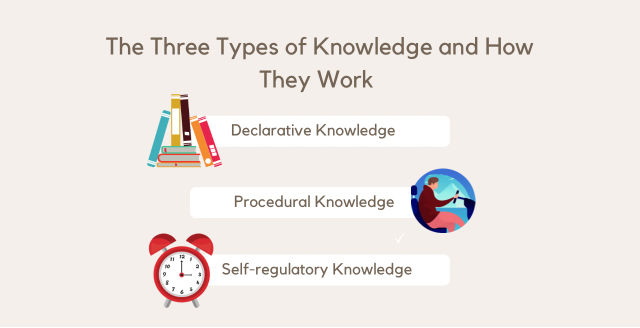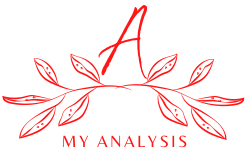
According to educational psychology, we can categorise knowledge into three types: declarative knowledge, procedural knowledge and self-regulatory knowledge. We have already discussed about this categorisation is some of the older posts, but in today’s post we will talk about them in more detail and try to figure out how we can develop each of this knowledge.
Declarative Knowledge:
Declarative knowledge is knowledge that can be declared through words and symbol systems of any kind. This is essentially knowledge of the fact or concept. When you learn from a textbook, write an equation, or learn alphabets, you are using declarative knowledge. The brain can chunk certain groups of declarative knowledge to form a coherent whole; for example, multiple letters can form words, or we can convert combinations of 3 laws into Newton’s 3 laws of motion. Eventually, combination of theories can make up an entire field like maths or physics.
There are many methods to learn declarative knowledge. Two of the most popular and scientifically accepted methods are to learn through memory palaces or through the use of flash cards.
Memory palace is a technique where you take advantage of the fact that your brain naturally remembers locations, and you create unusual images that are related to the concepts you are trying to memorise. For example, if I am trying to remember the word “cheese”, I would imagine Tom running after a cheese carrying Jerry outside my home. Coming up with the images won’t always be that easy, but this should give you an idea.
Flash card method uses concepts like active recall and spaced repetition to help students memorise concepts. In this method, a student just writes a question on one side of a flash card and the answer on the other side. The student is required to actively recall the answers to the questions before looking at the answer to verify if it was correct. But here comes the tricky part. It’s not enough to revise the concepts anytime during the day. You have to revise the concept at an interval just before your brain is about to forget the idea. As research shows, recalling something just as your brain is about to forget it strengthens the memory more than usual. But the exact time of forgetting is difficult to manually calculate. Fortunately, there are open source softwares like Anki that can help you calculate the exact time in which you are likely to forget a concept based on a certain algorithm.
If you are interested in the pros and cons of these methods, read this post.
Furthermore, the use of these concepts can be better strengthened by using ideas like chunking, dual coding and elaboration.
Chunking:
Chunking refers to the idea of breaking down information into smaller chunks to enable learning. Your short-term memory and your working memory have a certain limit. Usually you can only keep 7 +/- 2 individual units of information at a time. You can overcome this limitation by breaking down the information you are trying to learn into smaller pieces. The same principle can be applied to flash cards to make the ideas easier to digest. Instead of cramming several concepts into a single card, break them down into multiple cards. Even if the concept is too simple, keep it in a separate card. Only have the most important key information on one card. This will ensure that your short-term memory is not overloaded when trying to learn from a card. This is especially true when trying to learn a list. Don’t add over 9 items into a single card as this would be pushing the limits of your short-term memory. This limit shouldn’t be a problem once the information passes on to the long-term memory, but you need to be aware of it when learning new concepts.
Med School Insider has a video that explains the process of breaking down flash cards pretty well. Watch this.
The same can be the case with memory palaces. Do mix several concepts into a single mental image. This can often get confusing. Keep different concepts in smaller chunks.
Dual Coding:
Dual coding is the idea that an information can be better understood and remembered if it’s stored both as a word and as an image. For example, if you are trying to learn the structure of a neurone, it’s a good idea to read the description of the structure while simultaneously looking at an image of the neurone. Therefore, have an image of what you are trying to learn in the answer section of your flashcard whenever an image is available.
This idea would be difficult to implement for memory palaces because dual coding requires you to have the image of what you are trying to learn, while memory palace requires you to create unusual images of what you are trying to learn. Visualising the exact structure would go against the idea of memory palaces, which work based on the idea that the brain retains unusual images better. You will definitely face some situations where it’s too bothersome to make memory palaces. Think of dual coding to handle those situations. I, personally, almost never use memory palaces unless I need to memories something in a short amount of time. Even then, I don’t find memory palaces to be reliable when learning complex concepts, especially with the stress of exams.
Elaboration:
Elaboration is the process of learning new information by connecting it to what you already know. We frequently elaborate automatically, but we need to take active effort at times. The example I cited above for memory palace, the one using Tom and Jerry to remember the word cheese, is a form of elaboration because I used an old memory of a TV show to remember the new information called cheese. It becomes more complex with complex concepts, but the essential idea remains the same. Elaboration enhances memory and understanding by forcing you to analyse the new knowledge and connecting it to already existing knowledge. By doing so, you create a new neural pathway into the old knowledge, which in-turn facilitates access to the new information. The more deeply you analyse the information, the more likely you are to remember it.
Declarative knowledge – conclusion:
So, declarative knowledge is any type of knowledge that can be declared. You can learn this kind of knowledge through methods like memory palace or flashcards. Concepts like chunking, dual coding and elaboration can further help with the learning. That said, people must keep in mind that just memorising something is not the same as developing higher order learning in it. But that will be discussed on another post.
Procedural Knowledge:
The second kind of knowledge is procedural knowledge. Procedural knowledge is the knowledge of the “how to”. This is the knowledge of converting theory into practice. This need not be limited to physical actions, it includes application of theories and equations. When you solve a problem using a particular equation, you use procedural knowledge. Based on progressive training, a person can reach 3 stages of procedural knowledge.
Three Stages of Procedural Knowledge:
First stage is the cognitive stage. Cognitive stage is the stage where you have to think about each step of the procedure. In this stage you rely on declarative knowledge and general problem-solving strategy to get the work done. For example, if you have a manual, this is the stage in which you look at each step of the manual before doing a particular task.
Next is the associative stage, where one step flows into the other. In this stage 2 or more individual steps are combined and can be performed more smoothly. While there is a combination of few steps, not all steps are automated and you will still have to look at the manual to identify the next set of steps.
The associative stage leads to the autonomous stage where the entire process can be completed in one smooth flow with little attention being paid to the procedure. This is the stage in which you reach automation of the procedure and it can be performed without conscious thought.
Remember when I said your working memory has certain limitations? Once you reach the associative stage, you task you perform becomes automated and you won’t have to apply any conscious thought to perform the task. This means the working memory can be spent on something else. For example, you could accurately cut vegetables while having a conversation on phone or watching TV.
Drilling is a suitable method to develop procedural knowledge. You can repeatedly do a physical procedure to reach the autonomous stage. But, as we saw in this previous post, drilling is not a suitable method to develop conceptual understanding. It does not even aid memory. So, conceptual learning requires a novel approach, and that’s because application of these concepts to real life requires more context based training. This brings us to the third kind of knowledge.
Self-Regulatory Knowledge:
This is knowledge of how and when to use declarative and procedural knowledge. Whatever you are dealing with, life rarely offers a one size fits all solution. You can’t use the same method to overcome every single obstacle. That is why there are some skills that can never be automated. For example, consider driving. You can automate skills like turning the steering wheel or changing the gear, but you won’t be able to automate the act of changing lanes while driving. This is because your mind actively has to look at the nearby lane, see if it’s empty and then decide to change the lane. The entire process requires conscious attention. Imagine all the traffic accidents that would take place if people randomly changed lanes without thinking. Self-regulatory knowledge is the knowledge you need to understand the situation and make such strategic decisions; should I change the lane now? If yes, what is the process to change lanes?
Unlike procedural knowledge, self-regulatory knowledge cannot be learned through drilling. Self-regulatory knowledge is developed by dealing with different kinds of challenges and learning to problem solve your way out of it. It is not just about experience, you have to come up with efficient solutions to the problems you face. It would probably help if you have all the basic declarative knowledge and procedural knowledge of your field memorised and automated.
There you have it:
That would be the 3 types of knowledge as per educational psychology. Understanding what kind of information you are trying to learn can help you use the most appropriate strategy to learn the concept. Next time you learn something, think what category it falls under. See if any strategy I mentioned can be of use.
Source:
General information regarding the 3 kinds of knowledge is from Educational Psychology by Anita Woolfolk.
